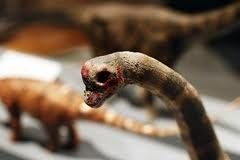Hollow Bones in Long-Necked Dinosaurs Linked to Survival of the Species

Research into the rapetosaurus, a long-necked dinosaur, has revealed new knowledge about its behaviour and living habits, particularly their survival in a harsh, drought-prone environment.
The existence of hollow bones in these dinosaurs is an anatomical revelation that sheds new light on their function, said Kristi Curry Rogers, lead author of a paper published in Tuesday's Nature Communications.
These insights may help solve one of the many mysteries surrounding the 50-foot long sauropod, an infraorder of saurischian or long-necked dinosaurs. The current understanding seems to be that the bones were used as reservoirs for vital minerals like calcium, which were needed to survive and reproduce.
Rogers, an assistant professor in geology and biology at Macalester College in Minnesota, and her colleagues, investigated a riverbed in Madagascar where they found several osteoderms (bony deposits forming scales, plates or other structures in the dermal layers of the skin). These create unusual patterns like those on the backs of crocodiles or the body covering of an armadillo. The dinosaur in question was an herbivore, much like the brachiosaurus, and lived in the late Cretaceous period.
It should be noted that among sauropods, osteoderms are found in one globally distributed subgroup - the titanosauria.
It's a theory at this point, but it's also a small contribution to the much larger dilemma that is just as relevant today as it was 65 million years ago, Rogers said, continuing, This is the biggest osteoderm ever found for any backboned-animal. The fact that it's hollow debunks all sorts of ideas about how these bones functioned in long-necked dinosaurs.
It helps us clarify what these Madagascar dinosaurs looked like with their skin on. Our sample also includes both adult and juvenile osteoderms, which tells us how the osteoderms changed over the lifespan of the dinosaur, added Rogers. In the surrounding area of the osteoderm, the skin of rapetosaurus would have stretched, making it, in places, up to seven times as thick as an elephant's skin, said the researchers.
However, instead of the hundreds of interlocking plates in live animals with osteoderms, the rapetosaurus had only a few. This means they were less likely to serve as protection or temperature regulators, the study noted.
The bone also hollowed out over the course of the dinosaur's lifespan. So even though it was massive, in the adult dinosaur, osteoderms would have actually been fairly lightweight, the assistant professor said.
Extreme swings in weather and environment shaped the fate of the dinosaurs and are shaping the modern world, too, she noted, adding, It gives us perspective on our own place and our fragile ecosystem.
© Copyright IBTimes 2024. All rights reserved.





















